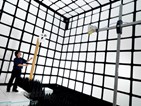Testing The T-Shirt Antenna

NPL worked with BAE Systems Advanced Technology Centre, to measure the pattern and efficiency of radiation emitted from next generation wearable antennas embedded in T-shirts.
Wearable antennas could be the future of wireless technology and have important applications in communications, security and healthcare, but as they are worn on the body it is particularly important to understand their performance. The human body absorbs electromagnetic signals and so there are concerns that the emitted signal from the antenna could suffer from power losses if worn too close.
The research tested a number of novel measurement techniques that could help the development of this exciting new technology, including measuring the radiation absorbed by a 'human dummy', designed from material that mimics the characteristics of human tissue.
Dr James Matthews, Principal Engineer, BAE Systems Advanced Technology Centre, said:
"NPL provided an excellent quality set of measurements, despite the difficulties inherent in wearable antenna technology. NPL took time to understand the requirements and took a proactive approach to the challenge, providing wider ranging measurements than originally anticipated."
NPL facilities used during the research included the Reverberation Chamber, Fully Anechoic Small Antenna Radiated Testing (SMART) Range, the EMC Ferrite Lined Fully Anechoic Room (FAR) and specific absorption rate (SAR) facilities.
The collaborative research revealed that there is an optimum distance for the position of the antenna in relation to the body, which can improve the antenna's efficiency. This information, when integrated into antenna design, will help developers produce better products.
Find out more about NPL's work in Wireless Communications.
For more information, please contact Dr Tian Hong Loh.
SOURCE: The National Physical Laboratory (NPL)
